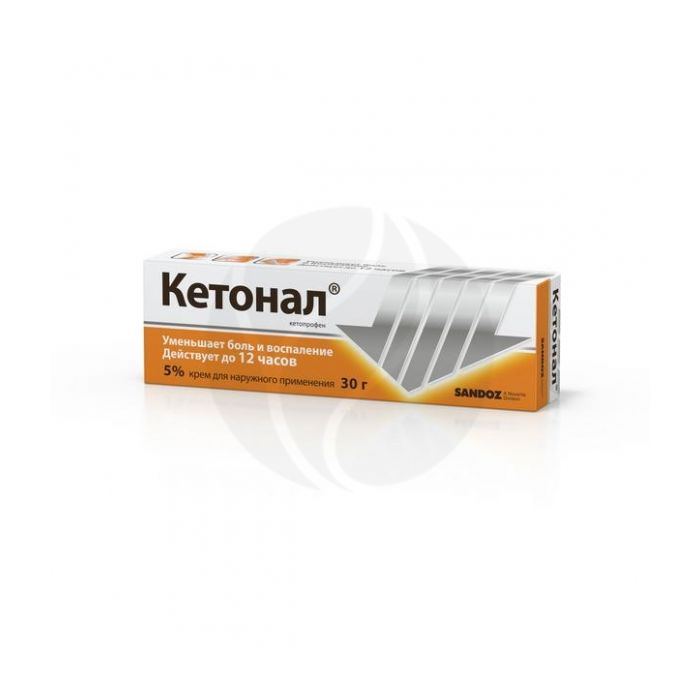Ketonal cream 5%, 30 g
Expiration Date: 05/2027
Russian Pharmacy name:
Кетонал крем 5%, 30 г
Symptomatic therapy - reduction of pain and inflammation - in the following conditions:
osteoarthritis of various localization;
periarthritis, tendonitis, bursitis, myalgia, neuralgia, sciatica;
injuries of the musculoskeletal system (including sports), contusion of muscles and ligaments, sprains, ruptures of ligaments and muscle tendons.
For external use.
A small amount of cream (3-5 cm) with light rubbing movements is applied with a thin layer on the skin of the inflamed or painful area of ??the body in accordance with its area 2 times a day.
The duration of the course of treatment without consulting a doctor should not exceed 14 days. If necessary, KetonalЃ cream can be combined with other dosage forms of KetonalЃ (capsules, tablets, rectal suppositories, solution for intravenous and intramuscular administration). The maximum dose of ketoprofen is 200 mg / day.
An occlusive dressing is not recommended.
If you forget to apply the cream, apply it at the time the next dose is due, but do not double it.
1 g of cream contains:
ketoprofen 50 mg,
excipients: methyl parahydroxybenzoate (methylhydroxybenzoate) 2.0 mg, propyl parahydroxybenzoate (propyl hydroxybenzoate) 0.5 mg, propylene glycol 70.0 mg, isopropyl myristate 50.0 mg, petrolatum (white) 320.0 mg, elfakos ST 9 30.0 mg, propylene glycol glyceryl oleate 90.0 mg, magnesium sulfate 5.0 mg, purified water 382.5 mg. '
Hypersensitivity to ketoprofen or other components of the drug, as well as to salicylates, tiaprofenic acid or other NSAIDs, fenofibrate, blockers of ultraviolet (UV) rays, fragrances;
an indication of a history of attacks of bronchial asthma or allergic rhinitis after the use of NSAIDs and salicylates;
III trimester of pregnancy;
children's age (up to 15 years old);
violation of the integrity of the skin in the area of ??application of the cream (eczema, acne, weeping dermatitis, open or infected wound);
history of photosensitivity reactions;
exposure to sunlight, incl. indirect sunlight and UV irradiation in a solarium throughout the entire period of treatment and for another 2 weeks after stopping treatment with the drug.
pharmachologic effect
NSAIDs. It has an analgesic, anti-inflammatory and anti-edema effect. Inhibits the activity of COX, which leads to inhibition of the synthesis of prostaglandins. In addition, ketoprofen inhibits lipoxygenase, bradykinin synthesis, stabilizes lysosomal membranes and prevents the release of enzymes involved in the inflammatory process.
Ketoprofen does not adversely affect the condition of the articular cartilage.
Side effect
Local reactions are the most common.
Allergic reactions: very rarely - angioedema, anaphylaxis.
On the part of the skin and skin appendages: infrequently - erythema, itching, burning, eczema, transient dermatitis of mild severity; rarely - urticaria, rash, photosensitivity, bullous dermatitis, purpura, erythema multiforme, lichenoid dermatitis, skin necrosis, Stevens-Johnson syndrome; very rarely - a single case of severe contact dermatitis (against the background of poor hygiene and insolation), a single case of severe generalized photodermatitis, toxic epidermal necrolysis.
From the respiratory system: very rarely - asthmatic attacks (as a variant of an allergic reaction).
From the urinary system: very rarely - a single case of deterioration of renal function in a patient with chronic renal failure; in isolated cases - interstitial nephritis.
Application during pregnancy and lactation
The drug is contraindicated for use in the third trimester of pregnancy.
Application in the I and II trimesters is possible in cases where the expected benefit of therapy to the mother outweighs the potential risk to the fetus.
The use of the drug during lactation (breastfeeding) is not recommended.
Application for violations of liver function
The drug should be prescribed with caution in case of liver dysfunction.
Application for impaired renal function
The drug should be prescribed with caution in case of impaired renal function.
Application in children
Contraindication: children under 12 years of age.
special instructions
Avoid getting the gel in the eyes, on the skin around the eyes, mucous membranes.
If any side effects appear, you must stop using the drug and consult a doctor.
If the patient has forgotten to apply the gel, it should be used at the time when the next dose is to be applied, but not doubled.
When skin reactions occur, incl. developed when used together with octocrylene-containing drugs, treatment should be stopped immediately.
To reduce the risk of developing photosensitivity, it is recommended to protect the gel-treated areas of the skin with clothing from UV exposure throughout the treatment period and for another 2 weeks after stopping the use of the gel.
Do not use as an occlusive dressing.
Hands should be washed thoroughly after each application of the drug.
Influence on the ability to drive vehicles and use mechanisms
Overdose
Symptoms: irritation, erythema, itching.
Treatment: you should stop using the drug, rinse the skin thoroughly with running water. The patient needs to see a doctor.
Drug interactions
Since the concentration of the drug in the blood plasma is extremely low, the manifestations of symptoms of interaction with other drugs (similar symptoms with systemic use) are possible only with frequent and prolonged use.
The simultaneous use of other forms for external and local use (ointments, gels) containing ketoprofen or other NSAIDs is not recommended.
The simultaneous administration of acetylsalicylic acid reduces the degree of binding of ketoprofen to blood plasma proteins.
Ketoprofen reduces the excretion of methotrexate and increases its toxicity.
Interaction with other drugs and the effect on their excretion are not significant.
Patients taking coumarin-containing anticoagulants are advised to undergo treatment under the supervision of a physician.

